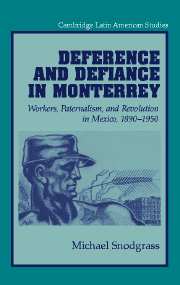Book contents
- Frontmatter
- Contents
- Acknowledgments
- Introduction
- 1 Porfirian Progress in “Mexico's Chicago”
- 2 Revolution Comes to Monterrey
- 3 Work, Gender, and Paternalism at the Cuauhtémoc Brewery
- 4 Making Steel and Forging Men at the Fundidora
- 5 The Democratic Principles of Our Revolution: Labor Movements and Labor Law in the 1920s
- 6 Every Class Has Its Leaders: ASARCO, The Great Depression, and Popular Protest in Monterrey
- 7 Stay with the Company or Go with the Reds
- 8 State Your Position!: Conservatives, Communists, and Cardenismo
- 9 The Quotas of Power: Organized Labor and the Politics of Consensus
- 10 The Persistence of Paternalism
- 11 The Institutionalized Revolution
- Select Bibliography of Primary Sources
- Index
9 - The Quotas of Power: Organized Labor and the Politics of Consensus
Published online by Cambridge University Press: 19 August 2009
- Frontmatter
- Contents
- Acknowledgments
- Introduction
- 1 Porfirian Progress in “Mexico's Chicago”
- 2 Revolution Comes to Monterrey
- 3 Work, Gender, and Paternalism at the Cuauhtémoc Brewery
- 4 Making Steel and Forging Men at the Fundidora
- 5 The Democratic Principles of Our Revolution: Labor Movements and Labor Law in the 1920s
- 6 Every Class Has Its Leaders: ASARCO, The Great Depression, and Popular Protest in Monterrey
- 7 Stay with the Company or Go with the Reds
- 8 State Your Position!: Conservatives, Communists, and Cardenismo
- 9 The Quotas of Power: Organized Labor and the Politics of Consensus
- 10 The Persistence of Paternalism
- 11 The Institutionalized Revolution
- Select Bibliography of Primary Sources
- Index
Summary
On the evening of July 29, 1936, the Nuevo León Workers Federation staged its weekly labor rally at a new venue. Whereas organizers generally held demonstrations before the state capital, they decided to meet on that night outside the nearby Casino Monterrey, the “exclusive club of the city's ‘aristocracy’.” As they later claimed, the protesters “wanted to mark the rude contrast of economic reality by presenting overalls and work boots on the front steps of the bourgeoisie's center of vice.” Among the other concerns expressed that evening was organized labor's demand that the government disband Nationalist Civic Action for being a “subversive” threat to the “constitutional regime.” It just so happened that the ACN was meeting one block away. Some 600 members had convened there to hear the lecture “Mexico Shall be Free in Spite of the Communists.” As the two-hour labor rally progressed, speakers were taunted by young ACN activists gathered on a nearby corner. A cordon of steel workers prevented the angered unionists from answering the provocations while orators interrupted their speeches to plead for workers to maintain their composure.
When the labor rally disbanded, an estimated 200 workers marched down the narrow street in front of the ACN's headquarters. The militants shouted revolutionary slogans and, according to later press reports, threw a few stones. Fearing “a bloody confrontation,” labor leader Tomás Cueva rushed to the head of the procession and prevented the workers from storming the building.
- Type
- Chapter
- Information
- Deference and Defiance in MonterreyWorkers, Paternalism, and Revolution in Mexico, 1890–1950, pp. 229 - 250Publisher: Cambridge University PressPrint publication year: 2003



